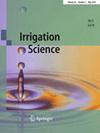基于无人机热成像和多光谱图像的双源能量平衡模型评价不同杏仁生产系统的蒸腾作用
IF 3.5
2区 农林科学
Q1 AGRONOMY
引用次数: 0
摘要
近年来,越来越多的杏仁作物集约化灌溉生产系统已经建立起来。然而,关于作物需水量的信息很少。基于遥感的模型,如双源能量平衡(TSEB)已被证明是准确估计实际作物蒸散的可靠方法。然而,在不同生产制度和水分状况的木本行作物中,很少有人通过液流测量来验证蒸腾作用。本研究采用Priestley-Taylor (TSEB- pt)和情境法(TSEB- 2t)模型对冠层蒸腾进行估算。此外,还评估了应用非均匀随机分布的丛状冠层基本丛状指数和矩形植物篱丛状指数对TSEB蒸腾估算的影响。TSEB输入是使用无人机从高分辨率多光谱和热成像中获得的。测定了叶面积指数(LAI)、茎水势(Ψ stem)和部分截获光合有效辐射(fIPAR)。不同的生产系统和灌溉处理在蒸腾方面存在显著差异。TSEB-2T与C&N-R透射率模型的联合使用对所有生产系统和灌溉处理的蒸腾估算都是最好的。在TSEB-2T模型中使用原位PAR透射率显著改善了均方根误差。因此,当使用C&N-R模型和原位PAR透射率时,与TSEB观察到的更好的一致性突出了改进辐射传输模型对短波冠层透射率的重要性,特别是在木本行作物中。本文章由计算机程序翻译,如有差异,请以英文原文为准。
Evaluation of transpiration in different almond production systems with two-source energy balance models from UAV thermal and multispectral imagery
Abstract A growing number of intensive irrigated production systems of the almond crop have been established in recent years. However, there is little information regarding the crop water requirements. Remote sensing-based models such as the two-source energy balance (TSEB) have proven to be reliable ways to accurately estimate actual crop evapotranspiration. However, few efforts have been made to validate the transpiration with sap flow measurements in woody row crops with different production systems and water status. In this study, the TSEB Priestley-Taylor (TSEB-PT) and contextual approach (TSEB-2T) models were assessed to estimate canopy transpiration. In addition, the effect of applying a basic clumping index for heterogeneous randomly placed clumped canopies and a rectangular hedgerow clumping index on the TSEB transpiration estimation was assessed. The TSEB inputs were obtained from high resolution multispectral and thermal imagery using an unmanned aerial vehicle. The leaf area index (LAI), stem water potential (Ψ stem ) and fractional intercepted photosynthetically active radiation (fIPAR) were also measured. Significant differences were observed in transpiration between production systems and irrigation treatments. The combined use of the TSEB-2T with the C&N-R transmittance model gave the best transpiration estimations for all production systems and irrigation treatments. The use of in situ PAR transmittance in the TSEB-2T model significantly improved the root mean squared error. Thus, the better agreement observed with the TSEB when using the C&N-R model and in situ PAR transmittance highlights the importance of improving radiative transfer models for shortwave canopy transmittance, especially in woody row crops.
求助全文
通过发布文献求助,成功后即可免费获取论文全文。
去求助
来源期刊

Irrigation Science
农林科学-农业工程
CiteScore
6.10
自引率
6.70%
发文量
69
审稿时长
5 months
期刊介绍:
Irrigation Science publishes original contributions and short communications reporting the results of irrigation related research, including relevant contributions from the plant, soil and atmospheric sciences and the analysis of field experimentation as well as irrigation water management modeling. Special emphasis is on multi-disciplinary studies dealing with the problems involved in maintaining the long term productivity of irrigated lands and in increasing the efficiency of agricultural water use.
Aspects of particular interest are: physiology of plant growth and yield response to water status; physical and chemical aspects of water status and movement in the plant-soil-atmosphere system; salinity and alkalinity control by soil and water management; agricultural drainage, measurement and modification of crop and control of water in plant, soil and atmosphere; water requirements in irrigation practice; irrigation scheduling and ecological aspects of irrigated agriculture.
 求助内容:
求助内容: 应助结果提醒方式:
应助结果提醒方式:


